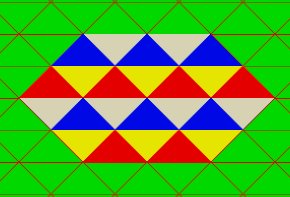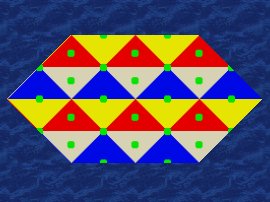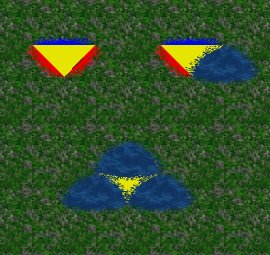Changes in HelpTerrains
Revision Differences of Revision 12
[TOC] ¶¶

¶
[TOC] ¶
Terrains are one of the base graphics in widelands. This page describes how they are implemented and should help with creating new terrains. ¶
In the end you'll find how to get your terrain in the game. ¶
¶
# Properties of the terrain patterns ¶
¶
The patterns for terrains do have some restrictions: ¶
¶
1. the width and height has to be 64 pixel ¶
2. they must be color indexed ¶
3. they couldn't get transparent areas ¶
¶
# Squared patterns as triangles ¶
¶
The surface of the widelands screen consists of a lot of triangles. See [geometry](https://wl.widelands.org/docs/wl/geometry/) for more about this issue. Each triangle of the surface is called "field" in this article. The squared terrain patterns are therefore splitted into triangles to fit the fields of the surface. This test pattern shows how the splitting is made: ¶
¶
 ¶
¶
The four colors represent the triangles in which the pattern is splitted while rendering. Only one of those triangles are displayed for each field: ¶
¶
 ¶
¶
Note that the red and white triangles of the original pattern are assembled from two patterns to get one big red and one big white triangle. In the above picture the patterns are knowingly spread, to help distuinguish the single patterns of each field. If all patterns are close together, it looks like this: ¶
¶
 ¶
¶
The patterns do have allways the same area where they adjoin: ¶
¶
Testpattern 2 | Result ¶
---------- | ---------- ¶
 |  ¶
¶
This is importand to create terrain patterns which do not have visible edges if the patterns of the same type adjoin. ¶
¶
# Implementing in the game ¶
¶
This section describes how the terrains patterns are impoplemeted in the game. Above you have seen, that the resulting triangles will have hard edges. But in game the edges are smooth. This is made with dithering.... ¶
¶
## Dithering ¶
¶
Different types of terrains do not have hard edges if they adjoin. This is made with dithering, a technique which blur the edges from one terrain type to another. Dithering could result in different results: ¶
¶
 ¶
¶
The above left example shows, that the testpatterns overlaps with the meadow terrain. The right one shows the opposit: The blue terrain overlaps the testpattern. If we use the blue terrain for all edges, the visible area of the testpattern shrinks drastically. Who decides which terrain dither over the other? ¶
¶
### Dithering configuration ¶
¶
The dithering is configured in the file `path/to/gamedata/widelands/world/terrains/init.lua` (for linux-systems) with the variable `dither_layer`. ¶
¶
**This settings are valid for the whole game. It is not possible to change this value during map creation or adjust it for each map different!** ¶
¶
Each terrain has its own dither_layer value. Terrains with higher values let the terrain dither over terrains with lesser values. Is the dither_layer value the same, no dithering is made. Examples which are used in chapter [dithering](#dithering): ¶
¶
Terrain | dither_layer | consequence ¶
-------- | --------- | ------------ ¶
testpattern | 220 | This overlaps the meadow terrain ¶
meadow | 120 | This pattern is covered by the testpattern ¶
blue | 240 | This terrain overlaps meadow and the testpattern ¶
¶
# Flags and buildings ¶
¶
# How to get your terrain into the game ¶
¶




